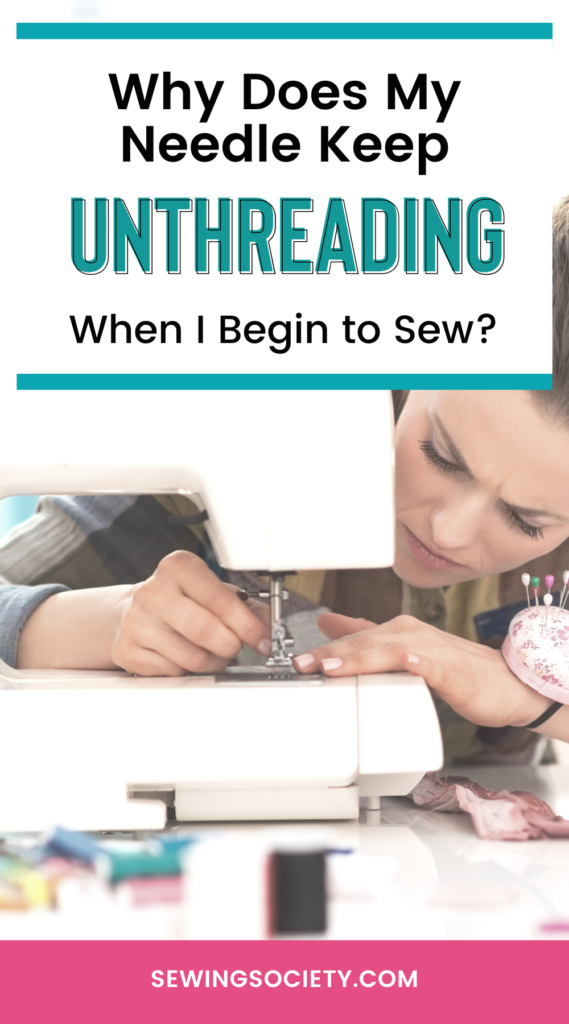Disclosure: This post may contain affiliate links. I earn a small commission when you click a link and make a purchase. Thanks for supporting SewingSociety.com!
Rethreading the needle on your sewing machine every few minutes is frustrating, especially if you don’t have an automatic needle threader to help you. I’m sorry the top thread keeps coming out of your needle! Luckily, it’s a common sewing machine problem that’s easy to solve.
Take a deep breath and let me help you fix it. Here are three common reasons why your needle keeps unthreading when you begin to sew, and what to do about each one.
Your Sewing Machine Is Not Threaded Correctly
Even people who have been sewing for years sometimes thread their sewing machines incorrectly. This is the first thing you should check if your sewing machine keeps unthreading or your stitches do not look right.
Unthread your sewing machine and rethread it from the beginning. Make sure your thread take-up lever is in its highest position, attach your spool of thread, and then pull your thread through your tension discs and thread guides according to the instructions in your user manual. Then, pull your thread through the eye of your needle and leave a four-inch tail of thread.
You Are Not Leaving Long Enough Thread Tails
After you thread your sewing machine, make sure that you leave at least three to four inches of thread hanging out of the end of your needle and bobbin. This is called your “thread tails.” If you don’t leave long enough thread tails, your thread can get pulled out of the eye of your needle when you begin to sew. This is especially true if you’re sewing knit fabric.
You can also try holding onto your thread tails when you begin to sew. After you have sewn a few stitches, you can let go. Just be careful that you do not pull on your threads because it can cause thread bunching or uneven stitching. Make sure to also keep your fingers clear of your needle.
Your Needle Is Not in Its Highest Position When You Start to Sew
Your top thread will pull out of your needle when you begin to sew if your needle and take-up lever are not in their highest position. Computerized sewing machines are usually programmed to stop with the needle in your fabric. This makes it easy for you to raise your presser foot and pivot as needed. If this is the case for you, you probably have a button that brings your needle up to its highest position.
If you have an older sewing machine, you must manually put your needle in its highest position. To do this, turn your handwheel until you see the take-up lever cannot go up any higher. Always turn your handwheel toward you to prevent throwing off your sewing machine’s timing or damaging the gears inside your machine.
Did you find this post helpful?
I can help you solve other sewing machine problems, too! Get a copy of my book, Sewing Machine Problems and How to Solve Them on Amazon.
Your sewing machine is going to give you troubles again.
It’s inevitable…
My troubleshooting book walks you through how to solve the 20 most common sewing machine problems. You’ll be prepared to tackle any problem your sewing machine throws at you. That means more time sewing and less time crying.
The ebook version only costs $2.99. You’d easily pay between $75 and $150 to take your sewing machine to a repair technician. Learn how to do a lot of the sewing machine troubleshooting yourself and save money. For more information, visit our Sewing Machine Troubleshooting Page.
Share this post on Pinterest!







Thanks for explaining that you shouldn’t ill on the thread once you put it in or it will bunch up. I have tried to sew my son’s jacket it up for about three hours now but the thread keeps messing up. I think I might be pulling it but if that doesn’t fix it then I am just going to take it to a repair shop.
Great post!
its still dong the same thing i leave a 5 in tail